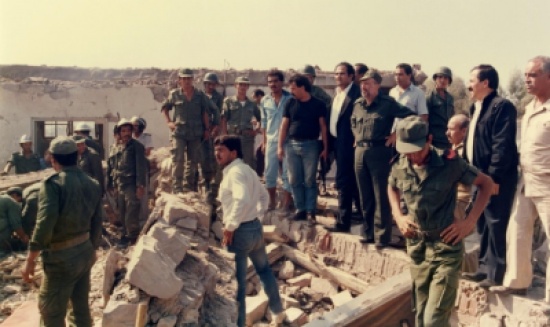News from Al-Madina The “Hammam al-Shatt” massacre in Tunisia, which claimed the lives of 50 Palestinian martyrs, 18 Tunisians, injured 100 people, and caused property losses worth an estimated $8.5 million, occurred 37 years ago today, on Saturday.
In an effort to immediately take out the leaders of the Palestinian revolt, the occupation planes commenced raids on the security square in the suburb of Hammam al-Shat, south of Tunisia’s capital, on Tuesday, October 1, 1985, in the morning.
The offices of the late president Yasser Arafat, his private residence, the Presidential Guard headquarters, the military administration that oversees the preservation of the records of the Palestinian revolution fighters, the financial administration, and some homes of Yasser Arafat’s associates and employees in the organization’s institutions were all flattened in less than ten minutes, with a focus on Pr
He made it out of the area 30 minutes before the blast and survived.
Another report of Yasser Arafat’s (Abu Ammar’s) survival said that he arrived at Tunis-Carthage Airport in the capital city of Tunis from Morocco on the eve of the massacre. A minister from Tunisia and some PLO members welcomed him. His convoy was noticed by Mossad personnel as it approached the organization’s headquarters in Hammam al-Shatt.
The Palestinian ambassador to Tunisia at the time, Hakam Balawi, sat in the passenger seat next to him and informed him that a significant Arab guest was waiting for him at the ambassador’s apartment in the Marsa Al-Naseem neighbourhood, north of the Tunisian city.
Yasser Arafat immediately gave his driver the order to exit the lengthy line of vehicles and head right in the direction of An-Naseem Marina, while the convoy continued on its usual path towards Hammam al-Shatt. Agents of Mossad were unaware of this abrupt transformation.
Arafat met with his Arab visitor in the mansion of Balawi’s reign, and since the meeting lasted well into the night, he made the decision to stay.
As soon as the operation was over, Arafat emerged and declared that he was still alive and well to the world over radio, television, and news organisations.
And at a time when the occupiers’ officials were celebrating his death, along with the deaths of numerous other PLO leaders, in the bombing campaign known as “the wooden leg.”
When Israeli Air Force officers led by Amos Lapidot and Mossad agents led by Nahum Admoni were getting ready to celebrate the massacre, Abu Ammar suddenly appeared to them, taking the top of the screens and standing on the rubble of his destroyed house, threatening Israel with a harsh response, according to the testimony of Taher al-Sheikh, the director of the “Palestinian News Agency – Wafa” office in Tunisia at the time.
Through its spies, the occupation discovered that the Palestinian leadership had scheduled a significant meeting for 9:30 a.m. on Tuesday, October 1, 1985, in its security square in Hammam al-Shatt. As a result, it prepared to attack the gathering in an attempt to accomplish what it had failed to do during its 88-day occupation and besiegement of Beirut in the summer of 1982.
Yasser Arafat was walking on the beach the morning of the meeting when the director of his military office called to tell him to postpone the meeting because several senior officers were unable to travel to Tunisia due to flight reservations, necessitating the postponement. The leadership had invited its officers and commanders in Algeria, Tunisia, and Yemen to join the meeting. The evening’s gathering.
Despite pleas to preserve it as a living witness to the Israeli crime, it was evident in a number of news reports lately released by Tunisian and Arab media networks that the consequences of the Israeli bombing of the Shatt Bath had vanished. Only the martyrs’ cemetery and the memorial statue in the martyrs’ square remain.
It was regarded as the largest occupation attempt to assassinate the revolution’s leaders, led by Yasser Arafat, and it may be the only one outside the borders of Lebanon in which the occupation is trying to eliminate Palestinian leaders by bombing warplanes. This is despite the paucity of information about these barbaric raids, the pictures that result from them, the few who wrote about them, and the names of those who died in them as martyrs.
Ali Abu Khadra, Muhammad Shehab, Muhammad Saeed Al-Issawi, Saleh Awad, Youssef Al-Daya, Huda Shaalan, and Nabil Qasha’am are some of the names of the massacre martyrs. Others include Abdul Aziz Ibrahim, Muhammad Ahmad Hijazi, Aziz Saleh Zaini, Faisal Mahmoud Sheridi, Munira Al-Husari, Najib Musa, and Ahmad Eid Hilal, Jihad Makari, Mahmoud Ma’ad, Mahmoud Al-Madani, Abdel Nasser Salibi, Hamed Abu Homs, Ahmed Omar Awad Jaber, Majdi Shafiq Al-Ansari, Saad Muhammad Badawi, Fouad Mustafa Abu Al-Fath, Muhammad Al-Ghoul, George Meriba, and Ali Jawhar, as
Arabs84.
How did Yasser Arafat survive the assassination 37 years after the “Hammam al-Shatt” massacre?

